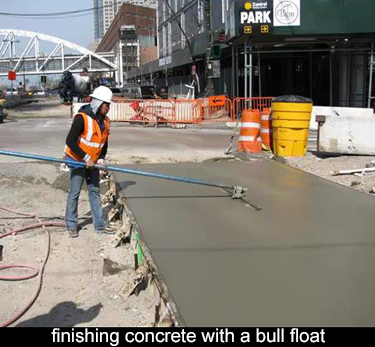Here's a close-up of the finishing machine that was used in the video. This is a very effective tool. It's certainly appropriate to the scale of the work here. It's small, it's portable. It's easy to handle and it's operated by a laborer on either side turning this winch. I don't want to leave you with the impression that this is how highway pavement is placed.
A typical highway job could be several miles long and it is paved using a totally different device. It's a mechanized piece of equipment which distributes the concrete over the width of the lane. You might even pave two lanes at a time and it moves the concrete horizontally across that width. It also finishes the concrete and it is a self-propelled machine. It doesn't look anything at all like this. I wanted to make that distinction. For the application here, this is a terrific device that does the job, but a full-blown highway project uses a totally different setup.
 After the finishing machine has struck off the concrete, the surface is smoothed out. This tool is called a bull float. The mason takes out any irregularities and produces a nice smooth finish. I have to make note, and I was struck at the job site by the fact that this is a woman. I don't think in my career I have ever seen a female mason, or their appearance is so rare that I was surprised to see this lady. It's delightful to see that the workforce is more and more integrated every year.
After the finishing machine has struck off the concrete, the surface is smoothed out. This tool is called a bull float. The mason takes out any irregularities and produces a nice smooth finish. I have to make note, and I was struck at the job site by the fact that this is a woman. I don't think in my career I have ever seen a female mason, or their appearance is so rare that I was surprised to see this lady. It's delightful to see that the workforce is more and more integrated every year.
Here, the surface is being scored with a tine. This is done to create a skid proof surface. This has to be done while the concrete is still wet or green. By the way, the term green is used to describe the concrete that has just been freshly placed. It does, in fact, have a green color.
You're familiar with the basket that holds the dowels at the location of each construction joint. The next activity is to sawcut the concrete above the basket of dowels and actually induce a crack at that point. This is done at frequent intervals. The goal here, of course, is to avoid random cracking of the concrete. Over the years, there have been many systems tried to incorporate some kind of a joint in the pavement.
You need to do this promptly on a hot day. You can do it the same day that the concrete is placed. These workers look like they are dressed for a winter. Chances are they come in and sawcut the pavement the next day,
These are winter conditions. You generally don't want to place concrete when the ambient temperature is below freezing. Sometimes 40 degrees is used as a cut-off, also, in the evening, temperatures are likely to drop even further. You can place concrete during the winter, if you use various safeguards. You can keep the sub base from freezing by covering it and protecting it and then you can also cover and protect the freshly placed concrete with insulated blankets.
 That's what's being done here. To keep the project on schedule, you cannot simply shut down for the winter, or even limit your activities during the winter. The goal is to try to keep the forward progress going, even during the cold weather. You can provide sufficient safeguards to protect the concrete. Under the most extreme conditions, where concrete absolutely must be placed, you can even construct enclosures and heat the enclosures in order to place concrete during the most challenging winters.
That's what's being done here. To keep the project on schedule, you cannot simply shut down for the winter, or even limit your activities during the winter. The goal is to try to keep the forward progress going, even during the cold weather. You can provide sufficient safeguards to protect the concrete. Under the most extreme conditions, where concrete absolutely must be placed, you can even construct enclosures and heat the enclosures in order to place concrete during the most challenging winters.
Here, in the New York City area, fairly modest steps can be taken to ensure that the concrete can be safely placed and cured. From the start of construction, from the very first slide to the time when all of the utilities were complete and the concrete was placed. That duration was approximately five months.
I've mentioned pedestrian walkways or pedestrian crossings. This is an illustration of one. Here, the area of the crossing was highlighted by using colored concrete. There are other areas where granite is used and that's even more impressive looking service. It's a great idea to differentiate between the normal pavement and the pedestrian crossing with some architectural feature.
It adds a cost to the project, but the result is permanent. You're not depending on maintaining the area with crosshatch paint or whatever is typically used. This is a very handsome approach, and it really should be considered in your project. Creating a separate pedestrian walkway like this is expensive. You have to interrupt the normal paving train and leave out this area. Then you come back and pour this area with several additional pours. Each different color requires a separate pour. There's a lot of additional work, but I think the project benefits from the result, and it's a very justifiable cost.